




Konrad Zuse - Biography
Today, in the whole world Konrad Zuse almost is unanimosly accepted as the creator / inventor of the first free programmable computer with a binary floating point and switching system, which really worked.
This machine - called Z3 - was completed in his small workshop in Berlin (Kreuzberg) in 1941. First thoughts Zuse's about the logical and technical principles are going back to 1934.
Konrad Zuse, also created the first programming language (1942-1945) of the world, called the Plankalkül.
In the past scientists and engineers had many discussions about the components of a computer and who can be accepted a the true inventor of the computer. In the scope of the International Conference on History of Computing from August 14-18, 1998, many scientist discussed on a panel session the question: Who is the inventor of the computer? After one hour discussion a great majority denoted Konrad Zuse as the most admired computer pioneer.
Konrad Zuse's Computers
The first question, which Konrad Zuse discussed in 1934, was: What mathematical problems should a computing machine solve? His answer was the following definition of computing (1936): To build new specifications from given given specifications by a prescription. In the year 1943 he extended the definition to: Computing is the deviation of result specifications to any specifications by a prescription.
From these definitions Konrad Zuse defined the architecture of his computers Z1, Z2, Z3 and Z4. His computers should be free programmable, it means that they should read arbitrary instructions from a punch tape, they should work in the binary digit system because Zuse wanted to contruct his computer with binary switching elements.
Not only the numbers should be represented in a binary form, but the whole logic of the machine should work in a binary switching mechanism (0-1-principle). He built a high performance floating point processor in the semi-logarithm representation, which allowed to calculated very small and very big numbers with a sufficient precison.
He implemented a high performance adder with a one-step carry and a precise arithmetic exceptions handling. He developed a memory where each cell could be addressed by the punch tape and could store arbitrary data. He constructed a control unit, which controlled the whole machine, and implemented input- and output devices in the decimal number system.
His first machine, which worked on these principles, was construction from 1936-1938 (Z1). The Z1 was a machine with a 64 cell (word) memory a 32 bits and the components as discussed above. The Z1 consisted completely of metal sheets. The clock frequency was around one Hertz. The Z1 is the first programable machine of the world.
Unsatisfied with the reliability of the binary switching metal sheets he constructed the Z2. The Z2 used the mechanical memory of the Z1, but for the arithmetic and control unit he used relays (800 relays) from the phone companies. The arithmetic unit consisted of a fixed point arithmetic unit because he wanted to test the arithmetic calculations for the exponent and mantissa.
The reliabilty of the relais convinced Konrad Zuse and he built the Z3 completely with relays (600 in the arithmetic unit and ca. 2800 for the memory and control unit).
It is undisputed today, that the Z3 was the first freely programmable, based on a binary floating system, working computer of the world. The Z3 did not store the program in the memory, but it contained in 1941 almost all the components of a modern computer as required by John von Neumann et al. in 1946.
The goal of the Z4 - developed between 1942 and 1945 - was a prototype of a series. The Worldwar 2 detroyed Konrad Zuse's hope, that his mchines should support the work of engineers.
From Vision to Reality
Now, Konrad Zuse formulated a vision. He wanted to release the spirits of humans from the stupid tasks of calculations. With the Plankalkül he wanted to capture the difficult problems of engineers in computer programs. The Plankalkül containt more than the pure statements for number calculations. Konrad Zuse also used rules of mathematical logic. It was clear for Zuse, that he wanted to formulate tasks for the computer to solve.
His idea was for example, to calcculate bridges. The input data for building bridges should be the type of the bridge and the conditions of the bridge related to the environment. The machine should propose a reliable bridge. He denoted such machines as logistische Maschinen (logistic machines) in opposite to the machine Z4 only appropriate for number calculation by programs (punch tapes).
Today, in the whole world Konrad Zuse almost is unanimosly accepted as the creator / inventor of the first free programmable computer with a binary floating point and switching system, which really worked.
This machine -
Konrad Zuse, also created the first programming language (1942-
In the past scientists and engineers had many discussions about the components of a computer and who can be accepted a the true inventor of the computer. In the scope of the International Conference on History of Computing from August 14-
Konrad Zuse's Computers
The first question, which Konrad Zuse discussed in 1934, was: What mathematical problems should a computing machine solve? His answer was the following definition of computing (1936): To build new specifications from given given specifications by a prescription. In the year 1943 he extended the definition to: Computing is the deviation of result specifications to any specifications by a prescription.
From these definitions Konrad Zuse defined the architecture of his computers Z1, Z2, Z3 and Z4. His computers should be free programmable, it means that they should read arbitrary instructions from a punch tape, they should work in the binary digit system because Zuse wanted to contruct his computer with binary switching elements.
Not only the numbers should be represented in a binary form, but the whole logic of the machine should work in a binary switching mechanism (0-
He implemented a high performance adder with a one-
His first machine, which worked on these principles, was construction from 1936-
Unsatisfied with the reliability of the binary switching metal sheets he constructed the Z2. The Z2 used the mechanical memory of the Z1, but for the arithmetic and control unit he used relays (800 relays) from the phone companies. The arithmetic unit consisted of a fixed point arithmetic unit because he wanted to test the arithmetic calculations for the exponent and mantissa.
The reliabilty of the relais convinced Konrad Zuse and he built the Z3 completely with relays (600 in the arithmetic unit and ca. 2800 for the memory and control unit).
It is undisputed today, that the Z3 was the first freely programmable, based on a binary floating system, working computer of the world. The Z3 did not store the program in the memory, but it contained in 1941 almost all the components of a modern computer as required by John von Neumann et al. in 1946.
The goal of the Z4 -
From Vision to Reality
Now, Konrad Zuse formulated a vision. He wanted to release the spirits of humans from the stupid tasks of calculations. With the Plankalkül he wanted to capture the difficult problems of engineers in computer programs. The Plankalkül containt more than the pure statements for number calculations. Konrad Zuse also used rules of mathematical logic. It was clear for Zuse, that he wanted to formulate tasks for the computer to solve.
His idea was for example, to calcculate bridges. The input data for building bridges should be the type of the bridge and the conditions of the bridge related to the environment. The machine should propose a reliable bridge. He denoted such machines as logistische Maschinen (logistic machines) in opposite to the machine Z4 only appropriate for number calculation by programs (punch tapes).
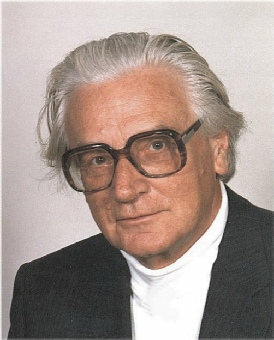
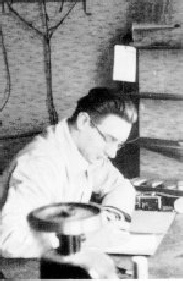
Konrad Zuse in 1985 and 1935. The Z1 in the living room of his parenets. The Z3 (reconstruction frm 1961). The Z4 at the ETH in Zürich (1950).
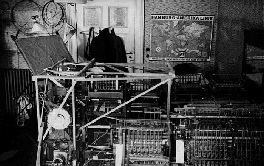
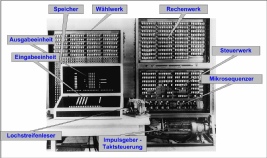
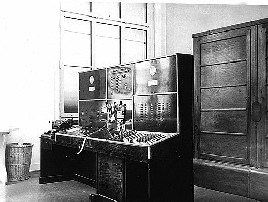
| Zuse-Apparatebau |
| Zuse 1936-1949 |
| Zuse KG (1949-1964) |
| Zuse KG - Computer |
| Z1 |
| Z1- Metal Sheets |
| Z2 |
| Z3 |
| Z4 |
| S1 |
| Z5 |
| Z11 |
| Z22 |
| Z23 |
| Z31 |
| Z64 |
| Z25 |